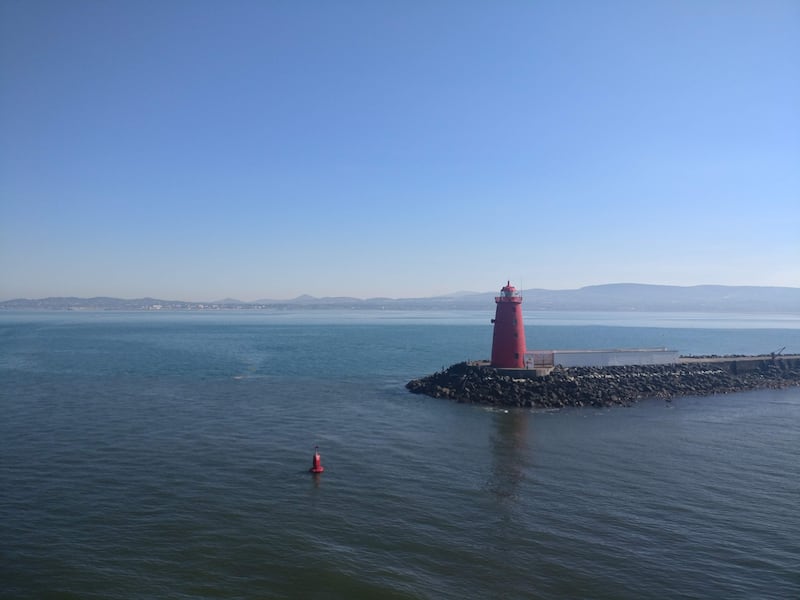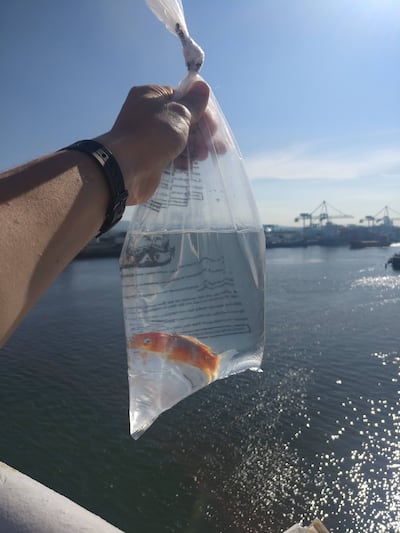I love getting the ferry. Compared with air travel, it’s a calmer, cheaper, lower-carbon way to go.
Over the past decade I’ve taken more than 20 “sail-rail” journeys, mainly from Dublin to London but also on to Brussels, Paris, Prague, Oxford, Edinburgh and Cambridge, among other places. It’s a less polished way of travelling than by air – although perhaps recent airport events have shifted that balance – but if you love trains and hate airports, it’s definitely something to try.
The process is nowhere near as easy as it should be, though, and I often get asked how to go about it. With luck, these tips and tricks will help future sail-railers have an easier time. (Some of the rail routes I mention are temporarily being affected by a reduction in services from Holyhead, so please factor these into your plans.)
Where can you go?
The basic idea is that you can buy a single sail-rail ticket to get a ferry from Dublin Port to Holyhead, in north Wales, and then take the train from there to anywhere in Britain. The ticket is good for as many train changes as you need in one day. It also works in reverse: a sail-rail ticket could be a train journey from any British rail station to Holyhead and then on to a ferry to Ireland.
READ MORE
You can go to London on this ticket and then get a separate Eurostar ticket, which can take you direct to a variety of European cities (Paris and Brussels most frequently). This isn’t always that cheap, and there can be tight connections, but it’s doable – especially if you have an obliging friend in London willing to host you on their couch for the night.
There are, of course, ferries going from Northern Ireland to Scotland, and from Rosslare and elsewhere. I only have recent experience with the Dublin Port to Holyhead route, however, so I can’t offer advice on the others.
How much does it cost?
Sail-rail tickets range from about €40 to €60. It’s a fairly fixed price range, so there are no big savings to be made by booking a long way in advance. This means it can be a good last-minute option. But be warned: the tickets do get booked out. You pay a bit extra (about €6) if you book a fast ferry or if you book on the day of travel.
A fare of €60 or so will take you to London or Edinburgh; the cheaper tickets are for destinations that are closer to Holyhead.
How long does it take?
My typical sail-rail trip involves leaving Dublin Port at 8.15am and arriving in London, at Euston Station, at 4.07pm. Coming home from London, I’d leave Euston at 9.10am and arrive in Dublin Port just before 5.30pm.
Obviously, the times can vary depending on your route or when in the day you want to travel. The train timings work out easier coming from London rather than going to London. On a recent trip to Edinburgh, I left at 8.20am and arrived just after 5pm.
In comparison with air travel, it’s obviously a much longer journey – but it’s not quite as big a gap as you think. Airports typically require you to arrive several hours before departure, and getting to and from the airports can add more hours to your day.
Sail-railing from London, for example, you only need to get to the station about 10 minutes before departure – or two minutes if you fancy a panicked sprint. You’re leaving from the well-connected city centre rather than from an airport that’s a big journey away.

On a recent trip it took me 15 minutes to get to Euston Station, where I waited 10 minutes before departure. Travelling by air would have meant leaving three hours or more before my flight. It’s worth judging the length of the journey door-to-door, not just the speed of the main section.
That said, getting to and from Dublin Port can be a bit of a pain, especially if you’re coming from outside Dublin. The port area is much bigger than you think, and walking to the ferry terminal isn’t a good option.
There are a few ways I’ve gone:
- Buses from Connolly (both the 53 Dublin Bus and Nolan Coaches) straight to the port – sometimes free, inexplicably, but sometimes €3.
- A Luas to the Point and a quick taxi from there (about €10).
- A taxi to the port terminal directly – it recently took 20 minutes (and cost €17) from Inchicore, Dublin to the terminal.
- If you’re bringing your bike (more on that later), you can just cycle there direct.
Another option is the Eurolines bus from Busáras, in Dublin city centre, all the way to London overnight (8pm to 8am), for €39. It might suit people who want to leave one evening and arrive the next morning in London. It’s also easier to start a journey at Busáras instead of Dublin Port. Personally, though, I’m not a huge fan of long bus journeys, so I’ve never done it.
Train and ferry times change, so while these details are up to date at the moment, you should double-check times with the providers.
Upcoming high-speed-rail works in the UK may also cut these journey times substantially, possibly to as little as 4½ hours from Dublin Port to central London.
Stena Line or Irish Ferries?
Stena Line and Irish Ferries, the two companies on the Holyhead to Dublin route, both offer the same sail-rail ticket, but you have to choose which company you’re going with when you book.
They have different terminals in Dublin Port, but there is only one terminal in Holyhead, which is, handily, also the train station.
They typically sail at similar times; both offer a slow sailing (about 3¼ hours); Irish Ferries also offers a fast sailing (about two hours). In my experience, Irish Ferries often has to cancel the fast sailing because of bad weather (especially in winter), but it has always accommodated me on the big slow ferry instead. If the fast ferry is cancelled, they’ll usually email and text you in advance.
Both companies are fine, but I slightly prefer Irish Ferries. It is the only one to offer the fast ferry, you can book online, and its terminal in Dublin lets you walk directly on to the boat. Stena Line drives you on via a bus, but its ferries are slightly nicer, so it’s a bit of a coin toss.

When do the ferries go?
Sail-rail passengers aren’t really a big moneymaker for the ferry companies. The boats are timed around people who are bringing their cars and for truck cargo. There are sailings from Dublin roughly at 2am, 2pm, 8pm etc, but in practice for sail-rail you’ll likely be going for a Dublin to Holyhead sailing at 8am or 8.15am.
Coming to Ireland, it will depend on the train you take, but you would usually aim for the Holyhead to Dublin sailing at 2.15pm or 2.45pm, depending on the ferry company.
The companies ask that you check in about 40 minutes before the sailing. I once arrived 10 minutes beforehand and just about got on. Apparently the ferry companies have become more strict about this in recent years.
I often book the fast ferry but bear the time of the slow ferry in mind, in case of cancellation.
How do you book?
I’ve found the easiest ways by far are:
Dublin to UK: Book direct via Irish Ferries or Stena Line. Irish Ferries lets you book on its website, while Stena still, bizarrely, asks you to phone. You then just pick up your ticket at the relevant check-in desk at the terminal. This is fairly handy. If you want, you can book a return ticket here too.
UK to Dublin: If you haven’t booked a return ticket, I recommend booking via the Trainline. It’s a handy, UK-based rail-ticket site. Booking this way also allows you to book a seat on your rail journey.
Much like Irish Rail, you book online and receive a reference code and you can collect your ticket from a machine at any UK rail station. You shouldn’t use this site to book journeys from Dublin: you’ll have to pay for the tickets to be posted to you, as you can’t collect them from an Irish station or ferry terminal.
If booking via the Trainline, you effectively choose the ferry company by your choice of destination port: “Dublin Ferryport” is Irish Ferries, “Dublin Port-Stena” is for Stena Line.
Recommended journey
The options can be bewildering. There are loads of destinations you might want to go to in the UK, and the Trainline website is a good way to plan the simplest routes.
But if you’re going to London, my favourite option is the 8.05am Irish Ferries sailing from Dublin Port, arriving in Holyhead at 11.30am. You then grab a coffee or lunch in Holyhead and get the 12.53pm direct train to London, arriving at 4.37pm. No train changes; nice and simple. There are faster ferries and earlier trains (you could leave Dublin at 7am-ish and be in London by 3.30pm, I think), but I find this route is quite reliable, taking the slow ferry and allowing plenty of time to get the train. It’s a nice, direct service, so you can really get comfortable and enjoy the lovely views along Colwyn Bay – a really beautiful spot.
For coming from London, I recommend getting the 9.10am train from London Euston to Holyhead. It arrives at 12.49pm, with a slow ferry at 2.10pm. That gets you to Dublin Port at 5.25pm. This route is as good as sail-rail gets, I think, and I’ve done it many times. I know some people who fly to London and get this route back, as a way to relax and read or work on the train.
Again, there are faster ways of doing it, but this is a nice, direct train, with plenty of time for transfers, so there’s no stress if delayed.
Luggage, bikes and pets
You can carry bags on to the ferry – they’re not fussy about allowances. There is an option to check in larger bags, but really the limit is whatever you can reasonably carry or wheel on to a train. It’s all fairly flexible – no messing about with liquids at airport security.
I took my bike by sail-rail a few years ago. They charged me an extra €10 and put it on the car deck of the ferry. It was very easy, and then I just brought it on the train.
The only pet I’ve ever taken on-board was a goldfish, which was very easy! From friends who have taken dogs and cats, I understand the process is easy enough. Trains in the UK are fairly tolerant of well-behaved pets, but no harm to double-check in advance. They can usually just be on a lead, as far as I have seen. On the ferry, the official policy is they should be put in a crate on the car deck, but you often see people bringing their dogs on-board.

Kids and accessibility
I’ve never travelled with kids, but you see quite a few large families on-board. If your kids are happy on a train, then the ferry should be much easier, and I think it would be reasonably workable. There’s plenty of space on the ferry, certainly.
In terms of accessibility, I don’t have personal experience of travelling on these services with friends with disabilities, but from what I can see the ferry is reasonably good in that regard. There can be a few steps on the ferry, but if you contact them in advance you can take lifts easily enough. However, as I don’t have a lot of knowledge about this, I don’t want to offer advice that may be unreliable.
What’s it like on-board?
The ferries are a bit dated, but essentially it feels like you’re waiting for a few hours in a hotel lobby. There’s a decent bar, some okay-if-overpriced carvery-like food, and a premium lounge (for €19) that offers free food, drink and wifi. I’ve never tried the lounge but will definitely book it next time to see what it’s like. There is also some kind of cinema for kids on-board.
You can also go out on deck, which is beautiful on a sunny day, and can always be relied on to windily blow out any sea sickness you have.
The wifi on the ferry has never worked for me. You can also use the boats’ At Sea mobile network – but I would strongly recommend not connecting to it, or just putting your phone in flight mode. Data roaming on the At Sea network is incredibly expensive. It’s best to wait until you arrive in Britain, where you can roam without much extra cost.
The wifi and phone signals are usually excellent on the direct train to London. If you need to, you can work efficiently throughout the journey.
Choosing the direct London to Holyhead train means you get a good-quality train with tables, plugs and internet access, similar to the Intercity trains in Ireland. The routes with more changes and transfers sometimes mean you’re on less comfy trains that are more like the Dart. This can have a big impact if you want to work or snooze.
Going to mainland Europe
I used sail-rail a lot when living in Brussels and, later, in London. It’s fairly straightforward from London, but Brussels is a little trickier. Eurostars don’t always go sufficiently early – or, when they do, they can be prohibitively expensive.
It can be done in one day (I’ve done it twice, both ways), but it takes a bit of research. Spending a night in London can be a good way to break up the journey.
Eurostars mainly go to Brussels and Paris, and the price varies a lot. Planning these journeys can be a bit of a maze, but I recommend a site like the excellent Man in Seat 61 to work out travel options.
Does it actually save much carbon?
I sometimes fly, but I personally dislike air travel. I also love trains, so I’m not totally motivated by climate concerns in choosing to sail and rail. I just prefer this as a way to travel when I can. I love the view from the train along Colwyn Bay, or the feeling of cruising on the open deck of the ferry by the Pigeon House into Dublin Port. After moving back home after eight years abroad, this is a memory that really sticks with me.
It’s tricky to calculate exactly how much carbon is involved in the ferry aspect. Most of the ferry is a combination of cars and cargo; foot passengers barely make a dent in it.
The Grantham Institute at Imperial College London found that sail-rail from Dublin to London emitted about 4kg of carbon, versus 74kg for a flight. That’s a saving of about 95 per cent. The Man in Seat 61 calculated a saving of about 73 per cent.
I have no expertise to judge the exact figures, it no doubt depends on how you count it. But I think it’s fairly clearly a big environmental saving.
Would I recommend sail-rail?
Absolutely, yes. It’s less polished than air travel, can be prone to delays, and is much less flexible. It could be so much better with a few changes – such as better train times, easier access to the port, and better information on the routes – but as it remains fairly niche it suffers from there being a relatively small number of people who use it.
If you’re hesitant about giving it a go, I’d recommend doing the London to Dublin route I recommended as a trial run. It often goes easiest.
When I lived in London a group of us used to get sail-rail home for Christmas and, despite some stiff hangovers, generally had a good laugh. The pub on-board is nice, and you can really take your time.
Sail-rail can be messy and frustrating. It’s not for everyone or for every journey. But I like it, I think it’s criminally underused, and suspect it’s for more people than you’d think. It is worth doing!
Michael Pidgeon is a Green Party councillor for Dublin’s South-West Inner City; a version of this article appears on his website











